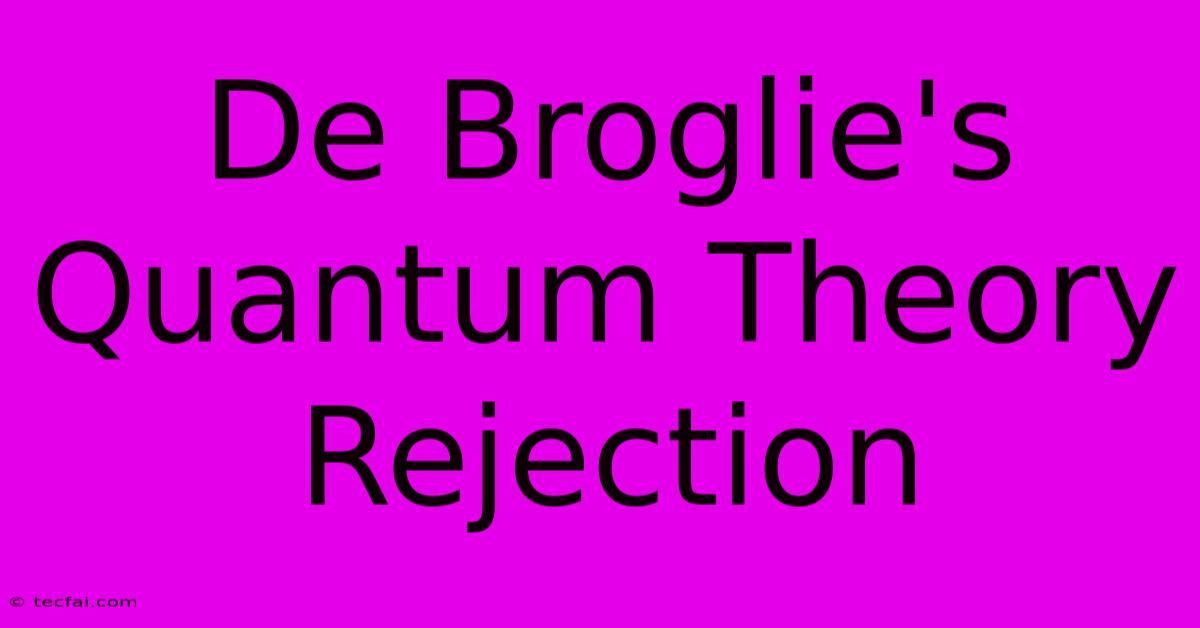De Broglie's Quantum Theory Rejection

Discover more detailed and exciting information on our website. Click the link below to start your adventure: Visit Best Website tecfai.com. Don't miss out!
Table of Contents
De Broglie's Quantum Theory: Rejection and Lasting Legacy
Louis de Broglie's revolutionary hypothesis proposing the wave-particle duality of matter, a cornerstone of quantum mechanics, wasn't immediately embraced by the scientific community. While ultimately groundbreaking, its initial reception was met with skepticism and outright rejection from several prominent figures. Understanding this initial resistance is crucial to appreciating the revolutionary nature of de Broglie's work and its eventual triumph.
The Initial Hurdles: Why the Rejection?
De Broglie's 1924 doctoral thesis, postulating that all matter possesses wave-like properties characterized by a wavelength inversely proportional to its momentum (λ = h/p, where h is Planck's constant and p is momentum), challenged the established classical physics paradigm. This paradigm firmly distinguished between particles, possessing definite trajectories and localized in space, and waves, spread out and described by wave functions. The idea that electrons, traditionally considered particles, could also behave as waves was radical.
Several factors contributed to the initial rejection of de Broglie's theory:
1. Lack of Experimental Evidence:
The most significant obstacle was the absence of direct experimental confirmation. De Broglie's hypothesis was purely theoretical, lacking empirical evidence to support its claims. While theoretical frameworks are crucial, the scientific method demands experimental validation. Without experimental data demonstrating the wave nature of matter, many physicists remained unconvinced.
2. Conceptual Difficulties:
The wave-particle duality was conceptually challenging. The notion that an object could simultaneously exhibit the characteristics of both a wave and a particle defied classical intuition. Reconciling these seemingly contradictory properties required a significant shift in thinking, a shift that many physicists were hesitant to make.
3. The Dominance of Classical Physics:
Classical physics, highly successful in explaining macroscopic phenomena, held a dominant position in the scientific community. De Broglie's radical departure from this established framework was met with resistance. Many physicists, deeply invested in classical paradigms, found it difficult to accept a theory that challenged their foundational understanding of the physical world.
4. Einstein's Initial Ambivalence:
Even Albert Einstein, a pioneer in revolutionizing physics, initially expressed reservations about de Broglie's work. While he recognized its potential significance, he wasn't immediately convinced, highlighting the audacious nature of de Broglie's proposal and the need for rigorous experimental proof.
The Turning Point: Experimental Verification
The tide began to turn with the experimental confirmation of de Broglie's hypothesis. The Davisson-Germer experiment in 1927 provided crucial evidence of electron diffraction, demonstrating the wave-like behavior of electrons. This landmark experiment, along with similar experiments involving other particles, provided the necessary empirical support for de Broglie's theory. This validation solidified the wave-particle duality concept as a fundamental aspect of quantum mechanics.
De Broglie's Enduring Legacy
Despite the initial rejection, de Broglie's work profoundly impacted the development of quantum mechanics. His hypothesis, initially met with skepticism, became a cornerstone of this revolutionary theory, fundamentally changing our understanding of the universe at the atomic and subatomic levels. The concept of wave-particle duality is now a fundamental concept taught in introductory quantum mechanics courses, a testament to the lasting impact of de Broglie's visionary work. His contribution continues to inspire research in fields like quantum computing and nanotechnology, highlighting the far-reaching implications of his initially controversial ideas. The story of De Broglie’s theory serves as a powerful reminder that even the most revolutionary scientific breakthroughs often face significant initial resistance before achieving widespread acceptance.

Thank you for visiting our website wich cover about De Broglie's Quantum Theory Rejection. We hope the information provided has been useful to you. Feel free to contact us if you have any questions or need further assistance. See you next time and dont miss to bookmark.
Featured Posts
-
Ucl Bayern Munich Vs Paris Sg Highlights
Nov 27, 2024
-
Five Survive Egypt Tourist Boat Sinking
Nov 27, 2024
-
Nsw Police Review Kristian Whites Future
Nov 27, 2024
-
Two Time Cy Young Winner Snell A Dodger
Nov 27, 2024
-
Top 10 Candidates For Unc Football Coach
Nov 27, 2024
